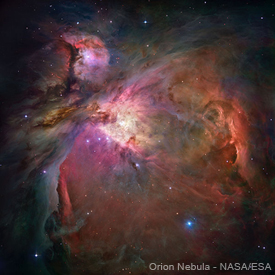
 Many amateur astronomers like to work with "Observing Lists" to help guide their night-time observing sessions. From lists for beginners to lists of hard-to-find objects, there are lists for everyone.
Many amateur astronomers like to work with "Observing Lists" to help guide their night-time observing sessions. From lists for beginners to lists of hard-to-find objects, there are lists for everyone.
The Star Finder star map has round circles around 10 objects. These are special objects which are visible either by the naked eye, or through binoculars. Of course, the higher magnification of a telescope gives even more details.
Learn more about these targets:
 Mira is a red super giant star which significantly changes in brightness. Many amateur astronomers measure the brightness of variable stars; that helps professional astronomers better understand stars. The AAVSO website shows how to do this. The distances to galaxies can be found by observing the brightness and periods of variable stars.
Mira is a red super giant star which significantly changes in brightness. Many amateur astronomers measure the brightness of variable stars; that helps professional astronomers better understand stars. The AAVSO website shows how to do this. The distances to galaxies can be found by observing the brightness and periods of variable stars.- Orion Nebula M42 can be seen with the unaided eye from a dark location or in binoculars from the city. Located just below the belt of Orion, it is a huge cloud of dust and gas. Gravity is pulling it into clumps which eventually ignite as stars. It glows because of bright stars which have already formed in it.
- Pleiades M45 is an open star cluster. This has many hundreds of stars which all formed from a nebula at roughly the same time. The Orion Nebula will become an open cluster in a few million years. This is a good test of eyesight. Some people can see 7 or more stars.
- Beehive Cluster M44 is another open cluster.
- The Hercules Cluster or M13 is a globular star cluster. It has hundreds of thousands rather than hundreds of stars, and is shaped like a sphere rather than flat like our solar system and many galaxies. Globular clusters are some of the oldest things in the universe.
The distance to each globular cluster can be found from variable stars. Much of this work was done at the David Dunlap observatory by Dr. Helen Hogg. From those distances, astronomers figured out the shape of the Milky Way, and our distance from the centre. - The Coat Hanger cluster is a group of unrelated stars which look like a coat hanger. This is in a star rich part of the Milky Way.
- Andromeda Galaxy or M31 is the most distant object most of us can see with our naked eyes. It has spiral arms, just like our Milky Way. There is a black hole in the centre. Almost all galaxies are moving away from us. This galaxy, however, is moving towards us and may pass through the Milky Way in 2 billion years. The Andromeda Galaxy, the Milky Way plus a few other galaxies form the local groups of galaxies. There are other clusters of galaxies in Virgo and Hercules, but telescopes are needed to see them.
- Mizar and Alcor form a double star. Some people with good vision can see that the middle star of the Big Dipper handle as a double star. Each of these is a double star with the stars orbiting each other. Almost half of solar systems have multiple stars. If Jupiter
 had been 90 times heavier, it would have ignited and formed into a second star. Then we would have had less night. Double star systems still have planets, but probably not as many.
had been 90 times heavier, it would have ignited and formed into a second star. Then we would have had less night. Double star systems still have planets, but probably not as many. - Double Cluster is two separate open clusters next to each other. One cluster is about 3 million years old, the other almost twice as old.
- Polaris is a fairly bright star which you would see straight overhead if you lay on your back at the North Pole. It stays in same spot of the sky, always within about a degree of true north. It is easy to find from the pointer stars of the Big Dipper. Some find North at night by finding Polaris. It is also used by amateur astronomers to adjust the alignment (polar align) of their telescopes. There is no bright star directly above the South Pole.

The most famous observing list is called the "Messier List", published by Charles Messier in 1771! Astronomical names that contain a code like "M44" or "M42" refer to their position on the Messier list.
The RASC has several Observing lists to challenge you. These lists will help you guide your observing sessions! The easiest is the "Explore the Universe Certificate". Print out the sheet. Find 55 out of 110 objects. When you complete a list, send the printed form in. RASC members will get a certificate and be mentioned on their website.
